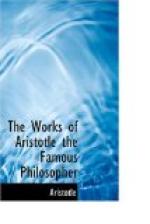Its use or proper action in the work of generation, is to receive and retain the seed, and deduce from it power and action by its heat, for the generation of the infant; and it is, therefore, absolutely necessary for the conservation of the species. It also seems by accident to receive and expel the impurities of the whole body, as when women have abundance of whites, and to purge away, from time to time, the superfluity of the blood, as when a woman is not with child.
SECT. II.—Of the difference between
the ancient and modern Physicians,
touching the woman’s
contributing seed for the Formation of the
Child.
Our modern anatomists and physicians are of different sentiments from the ancients touching the woman’s contributing seed for the formation of the child, as well as the man; the ancients strongly affirming it, but our modern authors being generally of another judgment. I will not make myself a party to this controversy, but set down impartially, yet briefly, the arguments on each side, and leave the judicious reader to judge for himself.
Though it is apparent, say the ancients, that the seed of man is the principal efficient and beginning of action, motion and generation, yet the woman affords seed, and contributes to the procreation of the child, it is evident from hence, that the woman had seminal vessels, which had been given her in vain if she wanted seminal excretions; but since nature forms nothing in vain, it must be granted that they were formed for the use of the seed and procreation, and fixed in their proper places, to operate and contribute virtue and efficiency to the seed; and this, say they, is further proved from hence, that if women at years of maturity use not copulation to eject their seed, they often fall into strange diseases, as appears by young women and virgins, and also it appears that, women are never better pleased than when they are often satisfied this way, which argues, that the pleasure and delight, say they, is double in women to what it is in men, for as the delight of men in copulation consists chiefly in the emission of the seed, so women are delighted, both in the emission of their own and the reception of the man’s.




